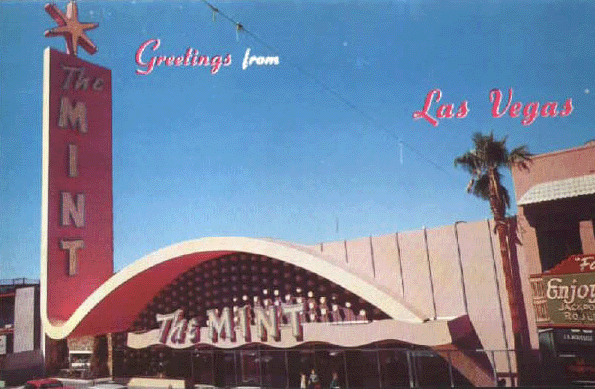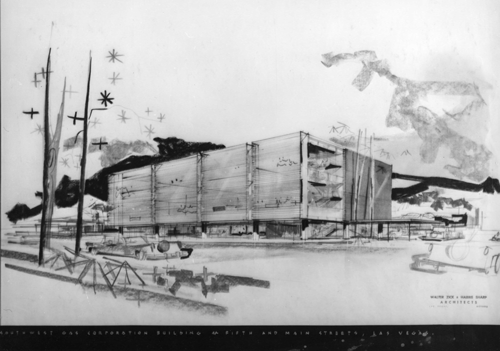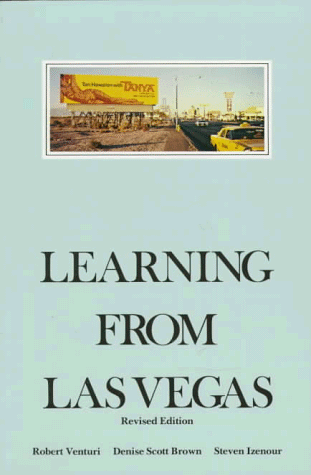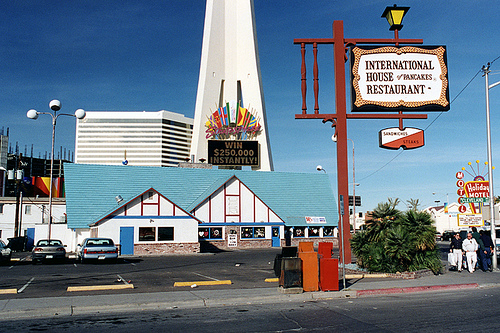Entries in automobile (29)
Beyond the Mint: Walter Zick and Mid-Century Las Vegas


If all Walter Zick and partner Harris Sharpe ever designed was the Mint Hotel and it's beautiful neon sign that would be enough.
But Walter Zick designed much more than just the most beloved, lost neon sign of Las Vegas. He designed a variety of commercial buildings, mainly banks, schools and residential homes.
A lot of his architecture is still standing which is really amazing considering the reputation Las Vegas has with preserving history.
As noted here earlier this year, we became much more aware of Walter Zick's architectural contribution to the Las Vegas Valley when we got a disc from Jack LeVine over at VeryVintageVegas that had been put together by Zick's daughters in hopes of having a school in the Valley named after their father.
While the School District turned down the daughters, we came up with an idea and working with the Nevada State Museum, Las Vegas and Nevada Humanities, we received a grant to do a program centered around Walter Zick and his mid-century architecture.
On October 3rd we will have a panel discussion at the State Museum on the work of Walter Zick. Confirmed panelists include our favorite mid-century author and historian, Alan Hess, Assemblage Studios' architect, Eric Strain, Karen Zick Goff and her sister, Claire and neon designer, Brian "Buzz" Leming.
Following the discussion, there will be an afternoon bus tour of some of Zick's still-standing architecture. The final stop on the tour will be the Morelli House. Though Zick did not design the Morelli House, it's mid-century architecture makes it a perfect place to have a small reception before returning to the State Museum.
We are currently working out the bus route, which we hope will include a few stops so that we can see the interiors of some of the buildings. Once we have all the details worked out, we will post them here.
Seating for the bus tour is limited and reservations will be necessary. Once we have the reservation number working, we will post that as well.
So, subscribe to this blog because you are not going to want to miss this. If you ever wondered what happened to mid-century modern Las Vegas or how it came to be, this is the program for you. If, like me, you've always appreciated how modern our Valley truly was, you won't want to miss this program.
It's going to be historic, fact-filled and lots of fun.
So, stay tuned.

This program made possible by Nevada Humanities and the Nevada State Museum and the generous donations of VeryVintageVegas, the Friends of Classic Las Vegas, Brian "Paco" Alvarez and the Junior League of Las Vegas.
Venturi and Brown Revisit "Learning from Las Vegas"

It is one of the iconic books about Las Vegas architecture, "Learning from Las Vegas". Written over forty years ago, this influential book, along with Alan Hess', "Viva Las Vegas: After-Hours Architecture", influences the way we look at the architecture of the Classic Las Vegas Strip.
Recently, Denise Scott Brown and Robert Venturi returned to Las Vegas to see how the landscape had changed in forty years. Their partner, Steven Izenour, passed away some time back.
From our pal Kristen Petersen at the Las Vegas Sun:
It’s 100 degrees. Everyone is sweating.
Architects Denise Scott Brown and Robert Venturi tour the Neon Boneyard, followed by a small crowd, some shaded by umbrellas. Cameras roll.
The Boneyard visit and a subsequent architectural bus tour are for a documentary on the architects whose famous 1968 study of Las Vegas launched an influential way of architectural thinking by observing what the people want, rather than what the architect dictates.
The project, begun five years ago by their son, Jim Venturi, delves into their working relationship, transformative years, observations, influences, ideas and projects, and has taken them around the world.
The Las Vegas stop is key. “Learning from Las Vegas,” a book of their study of the city as a prototype for 20th century American suburbia, became a formula for how they approached, and still approach, architecture.
Jim Venturi calls it a bedrock of his parents’ career, “the defining element that they are associated with by their willingness to look at things other people weren’t looking at.”
That the book remains topical in college curricula and contemporary conversation, even outside of architecture, is partly what inspired him.
“People had discovered their thinking and applied it outside the field,” he says. “Today you’ll find all kinds of interesting schools that are using ‘Learning from Las Vegas’ in the curriculum.”
Scott Brown, 77, and Venturi, 84, have received their share of criticism for their writings and designs — though they have their disciples and Venturi won the 1991 Pritzker Prize.
The film, Jim Venturi says, explains some of that: “You see the world from their perspective. You see their challenges. You learn about the experiences that shaped them.”
That, he says, includes their application of Eastern ideas and quest for balance.
John Halpern, known for his 1979 documentary on German artist Joseph Beuys, directs the film, one he says he would have given anything to be a part of: “Our main characters are amazing and complex.”
Halpern recalls Robert Venturi describing Palladio’s Basilica di San Giorgio Maggiore: “He revealed part of his mind, his mental process, his natural instinct for seeing art in its deeper meaning and esoteric impact. His sincerity, openness to and love of art and architecture moved me completely.”
Halpern describes Scott Brown as a powerful woman and architect, denied credibility in the “men’s club” of architecture. He’s also seen her open up:
“While describing her feelings and visionary ideas about architecture and the intricacies of city planning, (she) revealed a beautiful correlation between her body and sensorial experience in her art expression.”
Scott Brown says the project has been hard work, but has given them their lives back by revisiting the places where they shaped their ideas and careers.
Have they visited Vegas much?
“We have,” she says. “But who’s to know, this could be our last. But we say that everywhere.”
Harry Reid Backs Wrong High Speed Train to Vegas
Having just driven from Southern California to Las Vegas (and back), you would think that the idea of a high speed train would excite those of us who do the 4.5 hour drive on a regular basis. And the idea of a high speed train does interest me.
Just not the one that Sen. Harry Reid is backing. As reported here a few months ago, a battle is brewing over two companies that want to bring high-speed rail to Southern Nevada. The DesertXpress is the maglev train that would go from Anaheim to Las Vegas. You could leave Las Vegas and be at Disneyland without having to endure the notorious (and not getting any better) Southern California traffic jams. If you wanted to go to Los Angeles, you'd take one of the light-rail trains to Union Station. They have plans for a terminus in Palmdale to accomodate those in the high desert that want to go to Las Vegas.
The other high-speed train, the one that Sen. Reid is backing, would go from Victorville to Las Vegas. Yes, you read that right. Victorville. People in Southern California would have to drive to Victorville to take advantage of the train. And people visiting from Las Vegas, would have to rent a car in Victorville and drive into Los Angeles.
The worst part of the trip is usually getting through Southern California traffic just to get to Victorville. After that, the trip is usually less aggravating. The idea that the freeways in Southern California are only a problem during rush hour is an urban legend. About the only time the freeways aren't jammed are in the wee hours of the morning.
It is about 2.5 hours from Victorville to downtown Los Angeles. And it usually bumper to bumper for a good portion of that drive. And most people going to Los Angeles aren't staying downtown, so just getting to Downtown Los Angeles, still means you have more driving (and more sitting in traffic) to do.
So, we are scratching our heads over Sen. Reid's backing of a high-speed train that does not connect Southern California to Las Vegas but instead only goes part of the way.
It reminds us of the hype around the Las Vegas Monorail and we all know what a boon-doggle that became.
Let us know what you think! Would you take a train to Victorville?
From our friends at the Las Vegas Sun:
A high-speed train should be in place in 2012 that links Las Vegas and Southern California.
Senate Majority Leader Harry Reid today announced that plans are moving ahead for the DesertXpress train to Victorville, which is a private project. Reid had thrown his support behind the project, saying it had a better chance of getting built than an alternative maglev option that would have linked Las Vegas and Anaheim.
Officials hope to break ground in the first quarter of next year, with the project expected to be completed two years later.
As a private project, DesertXpress has insisted it has no interest in competing for $8 billion in federal recovery money — although more recently its backers said they may seek federal loans to help finance the $5 billion project.
Reid said today that plans are in place to link the project with California’s north-south trunk line "soon after" the Victorville project is complete, although no specific timeline is in place. The $45 billion trunk-line project links San Francisco and Southern California.
DesertXpress envisions a spur linking its Victorville stop to the California train’s Palmdale station, about 50 miles west. The Sun reported today that the U.S. Transportation secretary would announce the designation of a federal high-speed-rail corridor between Las Vegas and Southern California.
The one-way fare between Las Vegas and Southern California would be about $50.
DesertXpress is a private enterprise currently unaffiliated with a state agency.
Classic Las Vegas Downtown Memories
How many of these do you remember?
As promised, there is a point to all of this.

Coasters from the Mint Hotel (gone)

The Blue Angel Motel circa 1957

The Blue Angel Motel, circa 2007
 Nevada Club tourists (gone)
Nevada Club tourists (gone)

Ad ad for the Lady Luck, circa 1973 (sort of gone)

Golden Goose, circa 1973 (gone)

Fremont Street, 1991

The Ambassador Motel - 1952-2007 (gone)

Union Pacific Train Depot (gone), 1970

Chamber of Commerce ad, 1948

Main Street, 2008

Swim-In-Pool sign, (gone for now)

Not exactly downtown but the Skyway Drive-In (gone)
 St Joan of Arc Roman Catholic Church
St Joan of Arc Roman Catholic Church
 International House of Pancakes
International House of Pancakes
Tomorrow Classic Las Vegas neon!
Thanks to Allen Sandquist (RoadsidePictures) for letting us use these images!
Journalists Remember Frank Rosenthal
While the mayor and others wax nostaligically over the passing of Frank "Lefty" Rosenthal, journalists are less likely to be wearing rose colored glasses. These are some of the people who saw first hand the arrogance of Rosenthal and his crew (including his buddy, Tony Spilotro) as well as their criminal activities.
From the RJ's (and my pal) Jane Ann Morrison:
The few times Frank "Lefty" Rosenthal and I spoke, he looked at me as if I were a worm he'd like to step on, except the ensuing goo would dirty the sole of his shoe. Actually, I found the fastidious Rosenthal scarier than mobster Anthony Spilotro, and no one accused Rosenthal of killing dozens of people.
Now I've been on the receiving end of plenty of cold stares, but Rosenthal really gave it his all and his cold stare did a number on me when I was a federal court reporter between 1978 and 1984. Our first face-to-face encounter was during that period when he was unofficially running the Stardust when naïve California businessman Allen Glick was the owner. The Chicago Outfit put Rosenthal in. They used the nickname "Crazy" when they spoke of him.
He had various titles, from food and beverage director to entertainment director, but it was no secret he was concerned with more than how many blueberries were in a blueberry muffin and how tall the show girls were.
One day I was asked to be part of a panel of a few reporters to ask Rosenthal questions on a local television news show. I don't remember the exact date, but it was about the time he was running the Stardust, the Hacienda, the Marina and the Fremont, but didn't have a gaming license. When the time came for me to ask my first question, I caught Rosenthal's eye and froze. It seemed forever before I thawed out and had the sense to look at my notes and read a question.
In the game of intimidation, it was one for Frank, zero for Jane Ann.
The next time we spoke, he was leaving the federal courthouse wearing that silly hat he wore to cover his hair plugs. I tried to joke with him about what I assumed was his appearance before a grand jury meeting that day, asking whether he had spilled his guts. Maybe it was the hat and the awful hair plugs, but The Glare didn't turn me into a pillar of salt.
The last time I spoke with him was after he had cooperated with writer Nick Pileggi to write "Casino," the fascinating book that captured the Las Vegas of the 1970s and 1980s. Martin Scorsese's movie "Casino" was about to come out in 1995. Figuring Rosenthal was in the mood to talk about his Las Vegas days, I called him in Florida and said I'd like an interview. It was a pretty short conversation. Fortunately, I take rejection well.
Rosenthal had become a part of my daily life by then because of the memento that sat atop my computer.
Rosenthal's Cadillac exploded in 1982 in the parking lot between Tony Roma's and Marie Callender's on Sahara Avenue, just as he was getting in. While it was never solved, he said he didn't think the bombing was the work of the Boy Scouts.
I wasn't on the scene until the next day and spied a wire attached to a small piece of metal where the car had burned the asphalt. I didn't presume it was part of the bomb, but I did presume it was part of the car and for years it sat atop my computer in the newsroom, reminding me of a time when a car bombing did one of two things: It killed you. Or it sent you a message.
Rosenthal got the message and moved to Florida the next year.
About a month after the 1982 car bombing, his ex-wife Geri died in Hollywood from an apparent drug overdose. She was 46.
Spilotro, whose affair with Geri destroyed his friendship with Rosenthal, was murdered and dumped in an Indiana cornfield in 1986, courtesy of his mob bosses. He was 48.
Of the three, only Rosenthal died a natural death. This past Monday, the sports handicapper, whose lasting legacy was creating the first sports book in Las Vegas, had a fatal heart attack at 79.
My memories are fairly tame, but I know this: I'm not the only one who was on the receiving end of the Rosenthal Glare, which combined contempt with a touch of loathing and a hint of murderous rage. If you've seen it, you don't forget it.
From John L. Smith:
When I first heard Robert DeNiro had agreed to play a character based on Frank "Lefty" Rosenthal in the Martin Scorsese movie "Casino," I couldn't stop grinning.
It was just about perfect. I imagined Rosenthal, a man possessed of a positively gigantic ego, almost allowing himself to be impressed. DeNiro, Brando, Olivier, with the ghost of Cary Grant mixed in for good measure: That would have been ideal by Rosenthal's measure of himself and his place in gambling's Pantheon.
When I first learned from street sources Tuesday that Rosenthal had died of natural causes Monday in Florida at age 79, I didn't smile but only shrugged. A few months ago he'd promised me an interview, but I wouldn't agree to a small condition -- that he not be asked questions about his days as a Stardust casino executive, friend of Tony Spilotro, car-bombing survivor and Black Book member.
In other words, almost all the stuff that made his crazy life worth writing about was off-limits. Details of his death were sketchy, but a variety of sources said Rosenthal died of an apparent heart attack and was found at home by his daughter, Stephanie. Independent sources confirmed Rosenthal had placed his last wager and set his final line.
Here's a sample of reactions from locals who knew Rosenthal at the height of his power.
"It's been said you should never speak ill of the dead," one former federal organized crime prosecutor said. "There are exceptions to the rule. Frank Rosenthal is one of those exceptions. He was an awful human being."
Upon hearing the rumors of Rosenthal's demise, a longtime Spilotro friend said, "I hope it's true."
To settle such disputes, I like to turn to the irrepressible gambler Lem Banker, who knew Rosenthal well and respected his handicapping knowledge -- as well as his game-fixing skill.
"He was an egomaniac," Banker said. "But he was a smart sonofabitch."
Right on both accounts. Rosenthal arrived in Las Vegas from Chicago via Florida in the early 1970s and handicapped out of the Rose Bowl sports book, where the action was surpassed only by the Runyonesque characters. Marty Kane and Joey Boston worked for Rosenthal and became two of the most successful sports bettors.
How could they fail? They were allowed to fill out their betting slips after the games were concluded. Marty and Joey preceded Rosenthal in Black Book inclusion and death.
Banker respects Rosenthal's gambling acumen, but admits the guy would cheat a blind pencil salesman if given the chance. Activities such as past-posting illegal bookmakers and skimming casino profits were in Rosenthal's blood.
What's less appreciated is Rosenthal's tenacity. Call it a survival instinct or an expression of his egotism, but he fought like a cornered wildcat to keep a foothold in Las Vegas. He used attorney Oscar Goodman to sue everyone from Metro to state gaming authorities.
"He was a put-his-face-in-your-face type of guy," Mayor Goodman said. "He had no quit in him, and as a result didn't make any friends in law enforcement."
He won temporary reprieves, including a brief reversal of his 1988 Black Book inclusion, but in a changing Las Vegas, Rosenthal couldn't fade the heat.
Even his use of a weekly TV adulation fest called "The Frank Rosenthal Show" did little to keep him in the legal action. The man who helped write the "Outlaw Line" would remain an outlaw.
I think he stayed angry the rest of his life as he whiled away the years in consummate comfort in Boca Raton and Miami Beach, where he took up residence in a condominium in the Fontainebleau's Tresor Tower. (A Fontainebleau employee on Tuesday confirmed Roenthal's death.) He kept busy with his Web site, his handicapping, and a radio show.
Scorsese's "Casino" gave Rosenthal more than the best of it to the dismay of those who knew the truth about the Stardust's Frank-and-Tony show.
"The portrayal of him by Robert DeNiro was, as far as depicting his exterior, impeccable," Goodman said. "But as far as what made him tick, only Rosenthal knew that."
After "Casino," you'd think Lefty's ego would have finally been sated. Hardly.
Even 10 years after his inclusion on the "List of Excluded Persons," Rosenthal audaciously told me, "You couldn't put out a newspaper without Frank Rosenthal."
What he lacked in stature in the new Las Vegas, Rosenthal more than made up for in unabashed self-confidence.
He would ask, "Who 'invented' the modern sports book?"
Frank Rosenthal, of course.
Who brought vision and innovation to the casino industry?
Mr. Frank Rosenthal!
All true. But who fixed ballgames and cheated bookmakers from coast to coast? The right-handed guy nicknamed Lefty.
Who could justify a life underwritten by the Chicago Outfit and argue with a straight face that he wasn't associated with gangsters?
Only Frank Rosenthal.
You remember him.
He was in all the papers.
Later today, I'll be posting about yesterday's Historic Preservation Summit and more news including our upcoming panel on the MGM Grand Fire of 1980.
Stay tuned.



